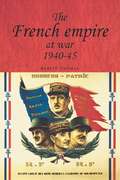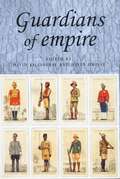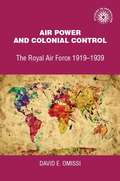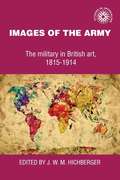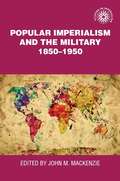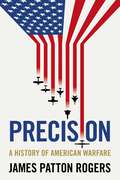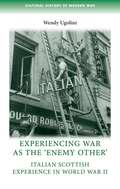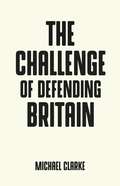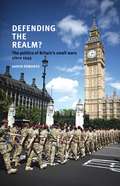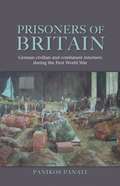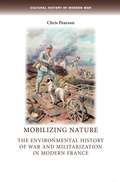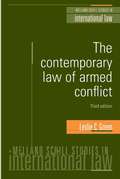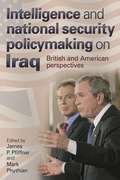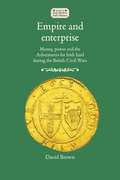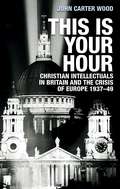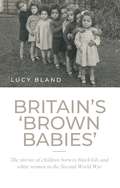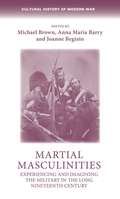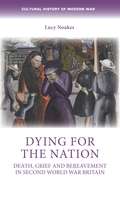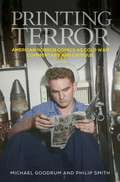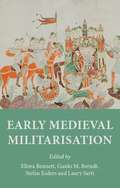- Table View
- List View
The French empire at War, 1940–1945 (Studies in Imperialism #29)
by Martin ThomasThe French empire at war draws on original research in France and Britain to investigate the history of the divided French empire – the Vichy and the Free French empires – during the Second World War. What emerges is a fascinating story. While it is clear that both the Vichy and Free French colonial authorities were only rarely masters of their own destiny during the war, preservation of limited imperial control served them both in different ways. The Vichy government exploited the empire in an effort to withstand German-Italian pressure for concessions in metropolitan France and it was key to its claim to be more than the mouthpiece of a defeated nation. For Free France too, the empire acquired a political and symbolic importance which far outweighed its material significance to the Gaullist war effort. As the war progressed, the Vichy empire lost ground to that of the Free French, something which has often been attributed to the attraction of the Gaullist mystique and the spirit of resistance in the colonies. In this radical new interpretation, Thomas argues that it was neither of these. The course of the war itself, and the initiatives of the major combatant powers, played the greatest part in the rise of the Gaullist empire and the demise of Vichy colonial control.
Guardians of Empire: The Armed Forces of the Colonial Powers, C.1700-1964 (Studies in Imperialism)
by David KillingrayFor imperialists, the concept of guardian is specifically to the armed forces that kept watch on the frontiers and in the heartlands of imperial territories. Large parts of Asia and Africa, and the islands of the Pacific and the Caribbean were imperial possessions. This book discusses how military requirements and North Indian military culture, shaped the cantonments and considers the problems posed by venereal diseases and alcohol, and the sanitary strategies pursued to combat them. The trans-border Pathan tribes remained an insistent problem in Indian defence between 1849 and 1947. The book examines the process by which the Dutch elite recruited military allies, and the contribution of Indonesian soldiers to the actual fighting. The idea of naval guardianship as expressed in the campaign against the South Pacific labour trade is examined. The book reveals the extent of military influence of the Schutztruppen on the political developments in the German protectorates in German South-West Africa and German East Africa. The U.S. Army, charged with defending the Pacific possessions of the Philippines and Hawaii, encountered a predicament similar to that of the mythological Cerberus. The regimentation of military families linked access to women with reliable service, and enabled the King's African Rifles to inspire a high level of discipline in its African soldiers, askaris. The book explains the political and military pressures which drove successive French governments to widen the scope of French military operations in Algeria between 1954 and 1958. It also explores gender issues and African colonial armies.
Air power and colonial control (Studies in Imperialism)
by David OmissiAir policing was used in many colonial possessions, but its most effective incidence occurred in the crescent of territory from north-eastern Africa, through South-West Arabia, to North West Frontier of India. This book talks about air policing and its role in offering a cheaper means of 'pacification' in the inter-war years. It illuminates the potentialities and limitations of the new aerial technology, and makes important contributions to the history of colonial resistance and its suppression. Air policing was employed in the campaign against Mohammed bin Abdulla Hassan and his Dervish following in Somaliland in early 1920. The book discusses the relationships between air control and the survival of Royal Air Force in Iraq and between air power and indirect imperialism in the Hashemite kingdoms. It discusses Hugh Trenchard's plans to substitute air for naval or coastal forces, and assesses the extent to which barriers of climate and geography continued to limit the exercise of air power. Indigenous responses include being terrified at the mere sight of aircraft to the successful adaptation to air power, which was hardly foreseen by either the opponents or the supporters of air policing. The book examines the ethical debates which were a continuous undercurrent to the stream of argument about repressive air power methods from a political and operational perspective. It compares air policing as practised by other European powers by highlighting the Rif war in Morocco, the Druze revolt in Syria, and Italy's war of reconquest in Libya.
Images of the army: The military in British art, 1815-1914 (Studies in Imperialism)
by J. W. M. HichbergerIn an age when engraving and photography were making artistic images available to a much wider public, artists were able to influence public attitudes more powerfully than ever before. This book examines works of art on military themes in relation to ruling-class ideologies about the army, war and the empire. The first part of the book is devoted to a chronological survey of battle painting, integrated with a study of contemporary military and political history. The chapters link the debate over the status and importance of battle painting to contemporary debates over the role of the army and its function at home and abroad. The second part discusses the intersection of ideologies about the army and military art, but is concerned with an examination of genre representations of soldiers. Another important theme which runs through the book is the relation of English to French military art. During the first eighty years of the period under review France was the cynosure of military artists, the school against which British critics measured their own, and the place from which innovations were imported and modified. In every generation after Waterloo battle painters visited France and often trained there. The book shows that military art, or the 'absence' of it, was one of the ways in which nationalist commentators articulated Britain's moral superiority. The final theme which underlies much of the book is the shifts which took place in the perception of heroes and hero-worship.
Popular imperialism and the military, 1850-1950 (Studies in Imperialism)
by John M. MacKenzieColonial war played a vital part in transforming the reputation of the military and placing it on a standing equal to that of the navy. The book is concerned with the interactive culture of colonial warfare, with the representation of the military in popular media at home, and how these images affected attitudes towards war itself and wider intellectual and institutional forces. It sets out to relate the changing image of the military to these fundamental facts. For the dominant people they were an atavistic form of war, shorn of guilt by Social Darwinian and racial ideas, and rendered less dangerous by the increasing technological gap between Europe and the world. Attempts to justify and understand war were naturally important to dominant people, for the extension of imperial power was seldom a peaceful process. The entertainment value of war in the British imperial experience does seem to have taken new and more intensive forms from roughly the middle of the nineteenth century. Themes such as the delusive seduction of martial music, the sketch of the music hall song, powerful mythic texts of popular imperialism, and heroic myths of empire are discussed extensively. The first important British war correspondent was William Howard Russell (1820-1907) of The Times, in the Crimea. The 1870s saw a dramatic change in the representation of the officer in British battle painting. Up to that point it was the officer's courage, tactical wisdom and social prestige that were put on display.
Precision: A history of American warfare
by James Patton RogersWe think of precision warfare as a modern invention, closely associated with the Gulf War, the Kosovo Campaign and drone technologies. But its origins go back much further in history.As historian James Patton Rogers reveals, this quest to achieve precision in war began in 1917, during the early years of powered flight in the United States. This means that precision has been a significant, if not always achievable, feature of American strategic thought for more than a hundred years.Patton Rogers takes readers on a journey through the twentieth century, highlighting the innovative thinkers of the First World War, the experimental technologies of the Second World War and the surprising Cold War nuclear strategies that made precision the dominant feature it is today. From Russia’s offensive war in Ukraine to Libya, Ethiopia and Nagorno-Karabakh, the conflicts of the twenty-first-century are being fought with precision weapons. Patton Rogers answers two enduring questions: why has precision been such a defining feature of US military thinking? And how has this ambition shaped public and military perceptions of war today?
Precision: A history of American warfare
by James Patton RogersWe think of precision warfare as a modern invention, closely associated with the Gulf War, the Kosovo Campaign and drone technologies. But its origins go back much further in history.As historian James Patton Rogers reveals, this quest to achieve precision in war began in 1917, during the early years of powered flight in the United States. This means that precision has been a significant, if not always achievable, feature of American strategic thought for more than a hundred years.Patton Rogers takes readers on a journey through the twentieth century, highlighting the innovative thinkers of the First World War, the experimental technologies of the Second World War and the surprising Cold War nuclear strategies that made precision the dominant feature it is today. From Russia’s offensive war in Ukraine to Libya, Ethiopia and Nagorno-Karabakh, the conflicts of the twenty-first-century are being fought with precision weapons. Patton Rogers answers two enduring questions: why has precision been such a defining feature of US military thinking? And how has this ambition shaped public and military perceptions of war today?
Experiencing war as the 'enemy other': Italian Scottish experience in World War II (Cultural History of Modern War)
by Wendy UgoliniAn original and engaging study which examines the impact of World War Two on the Italian community in Scotland.
The challenge of defending Britain (Pocket Politics)
by Michael ClarkeAn analysis that takes the complexity of British defence policy apart to view its anatomy and show how policy is made in this area. British defence policy is in a phase of great transition as the country confronts its Brexit future and also as world politics becomes more threatening and potentially unstable. This book uses the most up to date information to examine in a concise and readable way all the elements that go to make up Britain’s defence policy as it goes through the most significant transition since the end of the Cold War in 1991. By analyzing the costs of defence, the equipment issues, the personnel, the technical and intelligence back-up for it, and the strategies to employ military forces, this book offers a brief but rich guide to understanding an area of policy that many people find baffling.
Defending the realm?: The politics of Britain’s small wars since 1945
by Aaron EdwardsBritain is often revered for its extensive experience of waging ‘small wars’. Its long imperial history is littered with high profile counter-insurgency campaigns, thus marking it out as the world’s most seasoned practitioner of this type of warfare. This is the first book to detail the tactical and operational dynamics of Britain’s small wars, arguing that the military’s use of force was more heavily constrained by wider strategic and political considerations than previously admitted. Outlining the civil-military strategy followed by the British in Palestine, Malaya, Kenya, Cyprus, Aden, Northern Ireland, Iraq and Afghanistan, Defending the realm? argues that Britain’s small wars since 1945 were fought against the backdrop of an irrevocable decline in British power. Written from a theoretically-informed perspective, grounded in rich archival sources, oral testimonies and a revisionist reading of the literature on counter-insurgency and counter-terrorism, this is the definitive account of the politics of Britain’s small wars.
Prisoners of Britain: German civilian and combatant internees during the First World War
by Panikos PanayiDuring WWI hundreds of thousands of Germans faced incarceration in hundreds of camps on the British mainland. This is the first book on these German prisoners, and covers 3 different types of internees in Britain: civilians already present in the country in August 1914; civilians brought to Britain from all over the world; and combatants.
Mobilizing nature: The environmental history of war and militarization in modern France (Cultural History of Modern War #Cultural History of Modern War)
by Chris PearsonMobilizing nature traces the environmental history of war and militarisation in France. It offers a fresh perspective on the well-known conflicts whilst uncovering the largely 'hidden' history of the numerous military bases and other installations that pepper the French countryside.
The contemporary law of armed conflict: Third Edition (Melland Schill Studies in International Law)
by Leslie C. GreenGreen’s The contemporary law of armed conflict has been acclaimed as one of the most significant works on the law of armed conflict to appear in recent years. The first edition was adopted as a basic text by military institutions and educational establishments throughout the world and is among the most comprehensive and readable works on the subject. This new edition brings the work up to date, examining the significance of the World Court’s Opinion on the legality of the nuclear weapon. It also considers the importance of such matters as the laser weapon agreement, the mines treaty and the jurisprudence of the two war crimes tribunals, that for the former Yugoslavia as well as for Rwanda, and assesses the role of the proposed International Criminal Court as it may affect the law of armed conflict. The book applies a practical as well as a theoretical approach, and draws on an extensive range of national and international practice. It is thus an indispensable reference for the armed forces and government defence organizations, as well as academics and students interested in the modern law of war.
Intelligence and national security policymaking on Iraq: British and American perspectives
by James Pfiffner Mark PhythianThe decision to go to war in Iraq has had historic repercussions throughout the world. The editors of this volume bring together scholarly analysis of the decision-making in the U.S and U.K. that led to the war, inside accounts of CIA decision-making, and key speeches and documents related to going to war. The book presents a fascinating case study of decision-making at the highest levels in the United States and Britain as their leaders planned to go to war in Iraq. Just as the Cuban Missile Crisis has been used for decades as a case study in good decision-making, the decision to go to war in Iraq will be analysed for years to come for lessons about what can go wrong in decisions about war. The book presents a fascinating and truly comparative perspective on how President Bush and Prime Minister Blair took their countries to war in Iraq. Each had to convince his legislature and public that war was necessary, and both used intelligence in questionable ways to do so. This book brings together some of the best scholarship and most relevant documents on these important decisions that will reverberate for decades to come.
Empire and enterprise: Money, power and the Adventurers for Irish land during the British Civil Wars (Studies in Early Modern Irish History)
by David BrownThis book is about the transformation of England’s trade and government finances in the mid-seventeenth century, a revolution that destroyed Ireland. In 1642 a small group of merchants, the ‘Adventurers for Irish land’, raised an army to conquer Ireland but sent it instead to fight for parliament in England. Meeting secretly at Grocers Hall in London from 1642 to 1660, they laid the foundations of England’s empire and modern fiscal state. But a dispute over their Irish land entitlements led them to reject Cromwell’s Protectorate and plot to restore the monarchy. This is the first book to chart the relentless rise of the Adventurers and their profound political influence. It is essential reading for students of Britain and Ireland in the mid-seventeenth century, the origins of England’s empire and the Cromwellian land settlement.
Empire and enterprise: Money, power and the Adventurers for Irish land during the British Civil Wars (Studies in Early Modern Irish History)
by David BrownThis book is about the transformation of England’s trade and government finances in the mid-seventeenth century, a revolution that destroyed Ireland. In 1642 a small group of merchants, the ‘Adventurers for Irish land’, raised an army to conquer Ireland but sent it instead to fight for parliament in England. Meeting secretly at Grocers Hall in London from 1642 to 1660, they laid the foundations of England’s empire and modern fiscal state. But a dispute over their Irish land entitlements led them to reject Cromwell’s Protectorate and plot to restore the monarchy. This is the first book to chart the relentless rise of the Adventurers and their profound political influence. It is essential reading for students of Britain and Ireland in the mid-seventeenth century, the origins of England’s empire and the Cromwellian land settlement.
This is your hour: Christian intellectuals in Britain and the Crisis of Europe, 1937–49
by John Carter WoodIn the 1930s and 1940s – amid the crises of totalitarianism, war and a perceived cultural collapse in the democratic West – a high-profile group of mostly Christian intellectuals met to map out ‘middle ways’ through the ‘age of extremes’. Led by the missionary and ecumenist Joseph H. Oldham, the group included prominent writers, thinkers and activists such as T. S. Eliot, John Middleton Murry, Karl Mannheim, John Baillie, Alec Vidler, H. A. Hodges, Christopher Dawson, Kathleen Bliss and Michael Polanyi. The ‘Oldham group’ saw faith as a uniquely powerful resource for social and cultural renewal, and it represents a fascinating case study of efforts to renew freedom in a dramatic confrontation with totalitarianism. The group’s story will appeal to those interested in the cultural history of the Second World War and the issue of applying faith to the ‘modern’ social order.
Britain’s ‘brown babies’: The stories of children born to black GIs and white women in the Second World War (G - Reference, Information And Interdisciplinary Subjects Ser.)
by Lucy BlandThis book recounts a little-known history of the estimated 2,000 babies born to black GIs and white British women in the second world war. The African-American press named these children ‘brown babies’; the British called them ‘half-castes’. Black GIs, in this segregated army, were forbidden to marry their white girl-friends. Nearly half of the children were given up to children’s homes but few were adopted, thought ‘too hard to place’. There has been minimal study of these children and the difficulties they faced, such as racism in a (then) very white Britain, lack of family or a clear identity. The book will present the stories of over fifty of these children, their stories contextualised in terms of government policy and attitudes of the time. Accessibly written, with stories both heart-breaking and uplifting, the book is illustrated throughout with photographs.
Martial masculinities: Experiencing and imagining the military in the long nineteenth century (Cultural History of Modern War)
by Michael Brown Joanne Begiato Anna Maria BarryThis collection explores the role of martial masculinities in shaping nineteenth-century British culture and society in a period framed by two of the greatest wars the world had ever known. It offers a fresh, interdisciplinary perspective on an emerging field of study and draws on historical, literary, visual and musical sources to demonstrate the centrality of the military and its masculine dimensions in the shaping of Victorian and Edwardian personal and national identities. Focusing on both the experience of military service and its imaginative forms, it examines such topics as bodies and habits, families and domesticity, heroism and chivalry, religion and militarism, and youth and fantasy. This collection will be required reading for anyone interested in the cultures of war and masculinity in the long nineteenth century.
Martial masculinities: Experiencing and imagining the military in the long nineteenth century (Cultural History of Modern War)
by Michael Brown Joanne Begiato Anna Maria BarryThis collection explores the role of martial masculinities in shaping nineteenth-century British culture and society in a period framed by two of the greatest wars the world had ever known. It offers a fresh, interdisciplinary perspective on an emerging field of study and draws on historical, literary, visual and musical sources to demonstrate the centrality of the military and its masculine dimensions in the shaping of Victorian and Edwardian personal and national identities. Focusing on both the experience of military service and its imaginative forms, it examines such topics as bodies and habits, families and domesticity, heroism and chivalry, religion and militarism, and youth and fantasy. This collection will be required reading for anyone interested in the cultures of war and masculinity in the long nineteenth century.
Dying for the nation: Death, grief and bereavement in Second World War Britain (Cultural History of Modern War)
by Lucy NoakesDeath in war matters. It matters to the individual, threatened with their own death, or the death of loved ones. It matters to groups and communities who have to find ways to manage death, to support the bereaved and to dispose of bodies amidst the confusion of conflict. It matters to the state, which has to find ways of coping with mass death that convey a sense of gratitude and respect for the sacrifice of both the victims of war, and those that mourn in their wake. This social and cultural history of Britain in the Second World War places death at the heart of our understanding of the British experience of conflict. Drawing on a range of material, Dying for the nation demonstrates just how much death matters in wartime and examines the experience, management and memory of death. The book will appeal to anyone with an interest in the social and cultural history of Britain in the Second World War.
Dying for the nation: Death, grief and bereavement in Second World War Britain (Cultural History of Modern War)
by Lucy NoakesDeath in war matters. It matters to the individual, threatened with their own death, or the death of loved ones. It matters to groups and communities who have to find ways to manage death, to support the bereaved and to dispose of bodies amidst the confusion of conflict. It matters to the state, which has to find ways of coping with mass death that convey a sense of gratitude and respect for the sacrifice of both the victims of war, and those that mourn in their wake. This social and cultural history of Britain in the Second World War places death at the heart of our understanding of the British experience of conflict. Drawing on a range of material, Dying for the nation demonstrates just how much death matters in wartime and examines the experience, management and memory of death. The book will appeal to anyone with an interest in the social and cultural history of Britain in the Second World War.
Printing terror: American horror comics as Cold War commentary and critique
by Michael Goodrum Philip SmithPrinting Terror places horror comics of the Cold War in dialogue with the anxieties of their age. It rejects the narrative of horror comics as inherently, and necessarily, subversive and explores, instead, the ways in which these texts manifest white male fears over America’s changing sociological landscape. It examines two eras: the pre-CCA period of the 1940s up to 1954, and the post-CCA era to 1975. The book examines each of these periods through the lenses of war, gender, and race, demonstrating that horror comics at this time were centered on white male victimhood and the monstrosity of the gendered and/or racialised other. It is of interest to scholars of horror, comics studies, and American history.
Printing terror: American horror comics as Cold War commentary and critique
by Michael Goodrum Philip SmithPrinting Terror places horror comics of the Cold War in dialogue with the anxieties of their age. It rejects the narrative of horror comics as inherently, and necessarily, subversive and explores, instead, the ways in which these texts manifest white male fears over America’s changing sociological landscape. It examines two eras: the pre-CCA period of the 1940s up to 1954, and the post-CCA era to 1975. The book examines each of these periods through the lenses of war, gender, and race, demonstrating that horror comics at this time were centered on white male victimhood and the monstrosity of the gendered and/or racialised other. It is of interest to scholars of horror, comics studies, and American history.
Early medieval militarisation
by Ellora Bennett Guido M. Berndt Stefan Esders Laury SartiThe societies of ancient Europe underwent a continual process of militarisation, and this would come to be a defining characteristic of the early Middle Ages. The process was neither linear nor mono-causal, but it affected society as a whole, encompassing features like the lack of demarcation between the military and civil spheres of the population, the significance attributed to weapons beyond their military function and the wide recognition of martial values. Early medieval militarisation assembles twenty studies that use both written and archaeological evidence to explore the phenomenon of militarisation and its impact on the development of the societies of early medieval Europe. The interdisciplinary investigations break new ground and will be essential reading for scholars and students of related fields, as well as non-specialists with an interest in early medieval history.
